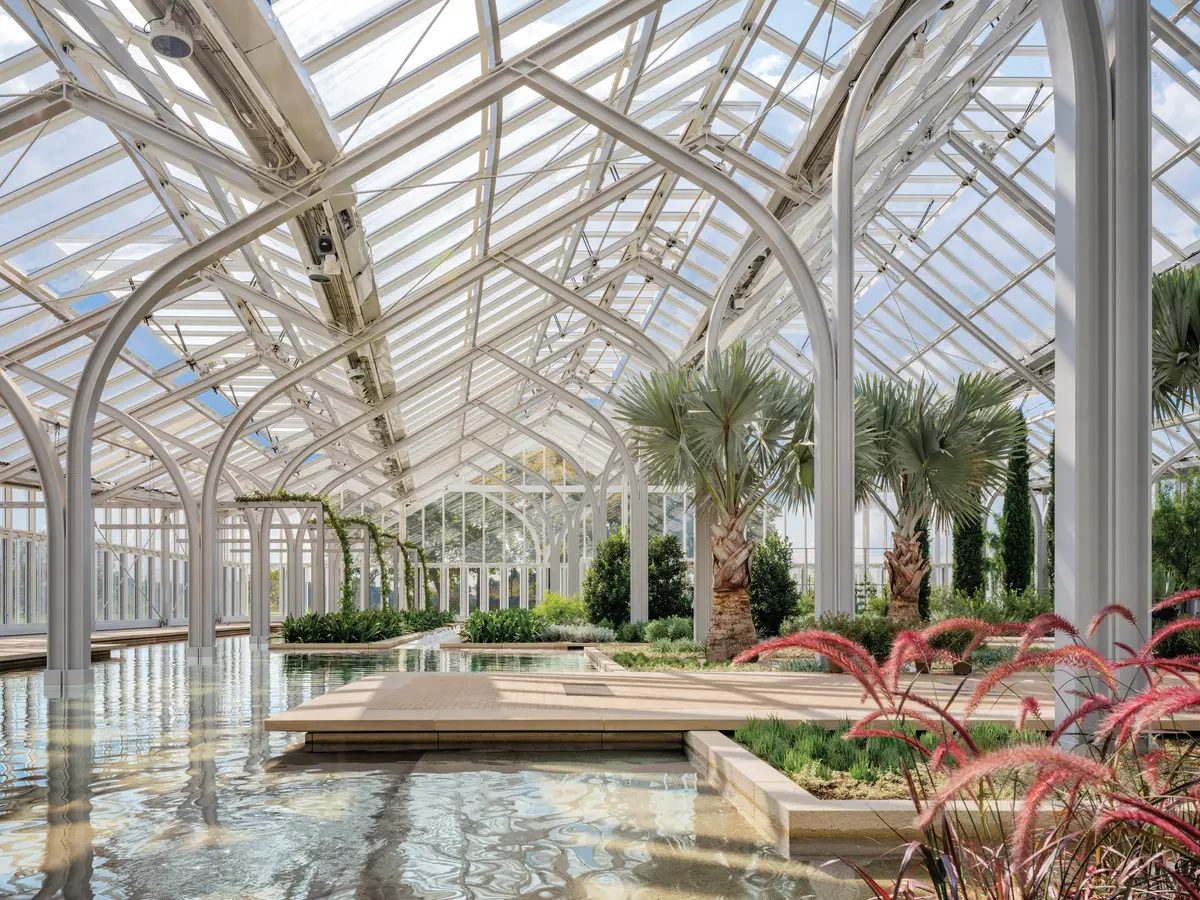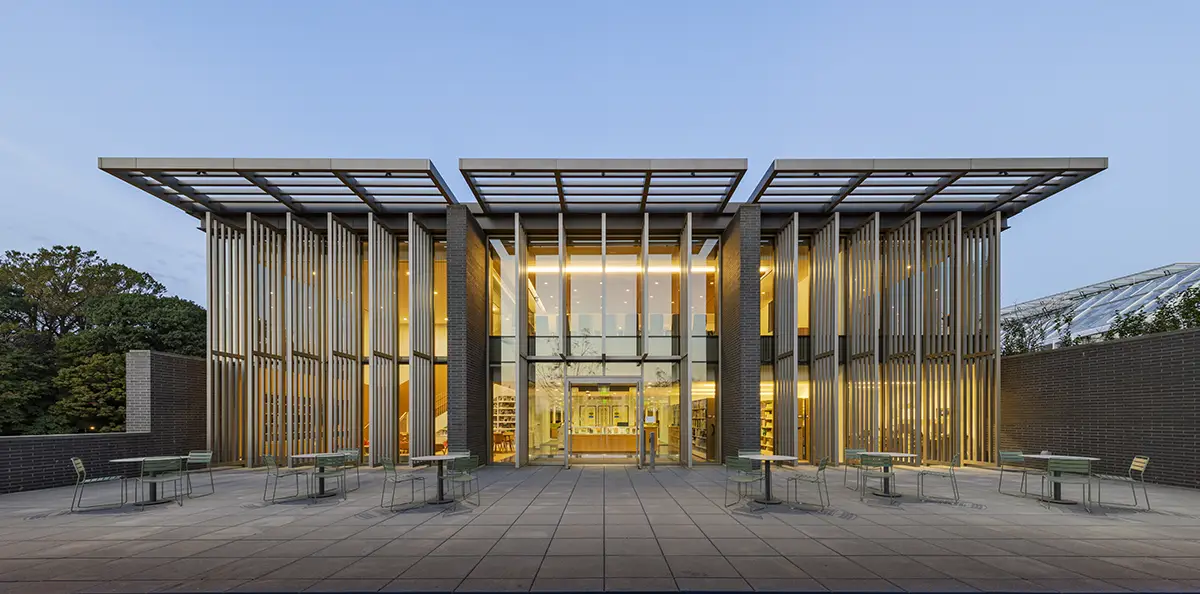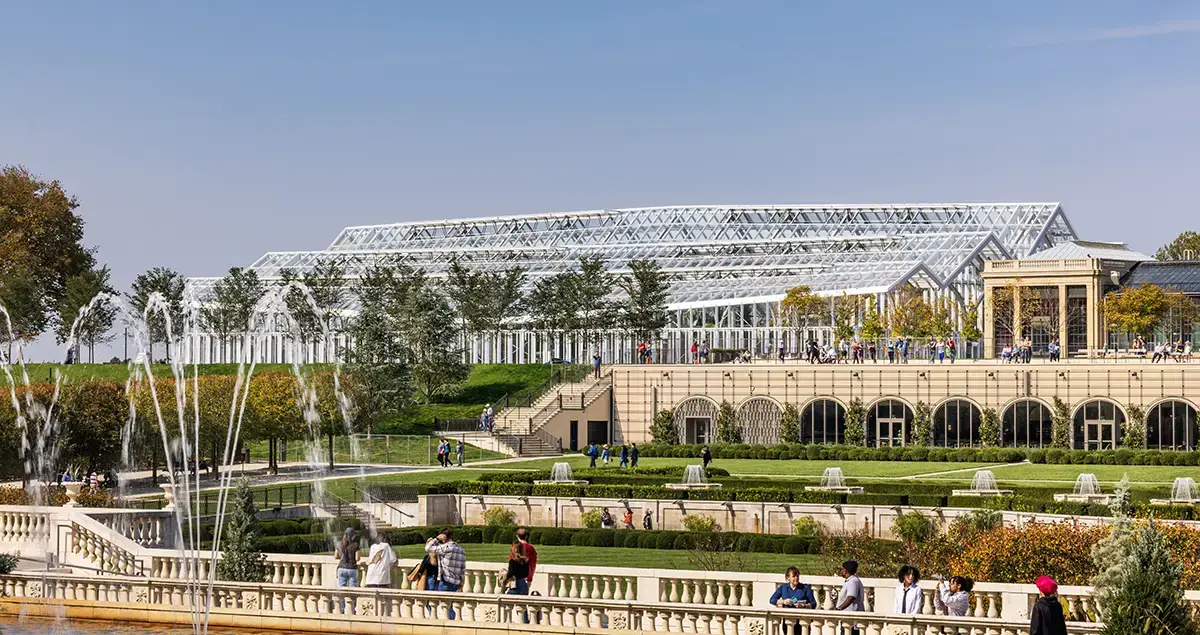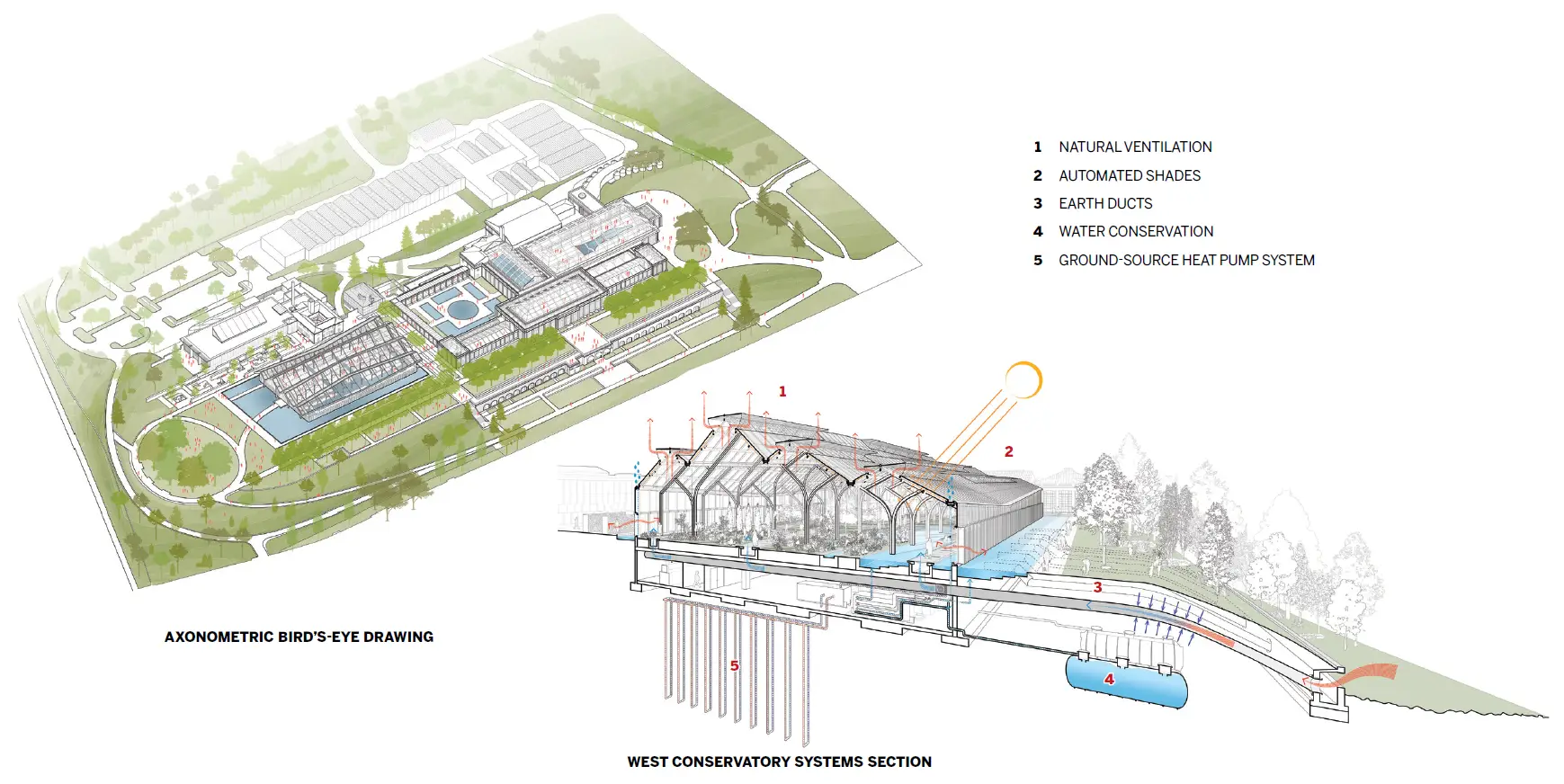Landscape
Weiss/Manfredi and Reed Hilderbrand’s Revamp of Longwood Gardens Reaches Full Bloom
Chester County, Pennsylvania

The West Conservatory at Longwood Gardens. Photo © Albert Vecerka/Esto
As a passionate admirer (and engineer) of water in the landscape, the late American industrialist Pierre S. du Pont would be thrilled to return today to Longwood Gardens, his country estate-turned-horticultural wonderland in southeast Pennsylvania’s Brandywine Valley.
Now rising atop a ridgeline at the 1,100-acre public garden is a state-of-the-art glasshouse that appears to hover above a shallow 175,000-gallon pool. This ethereal intersection of water and steel-supported glass architecture continues inside of the newly opened West Conservatory, home to Longwood’s expanded Mediterranean Garden. Here guests can traverse a lush landscape of low fountains, canals, pools, planted islands, and other water features totaling more than 8,000 square feet.

1
Anchoring Longwood’s reimagined core conservatory area (1), the new West Conservatory (top of page) is home to a Mediterranean-inspired garden (2). Photos © Sahar Coston-Hardy/Esto, click to enlarge.

2
Topped by a pleated roof with crisp asymmetrical peaks that define Longwood’s new “crystalline ridge,” the 32,000-square-foot West Conservatory is the centerpiece of a $250 million revitalization project.

Roughly 600 of the West Conservatory’s nearly 2,000 glass panels feature fritted patterns meant to prevent bird strikes. Photo © Albert Vecerka/Esto
Helmed by New York–based Weiss/Manfredi in the role of lead designer and master planner in collaboration with landscape architecture practice Reed Hilderbrand, the project encompasses 17 acres of the century-old garden’s core conservatory area. Several major elements completed as part of the overhaul also opened in late November alongside the West Conservatory. Overseen by Longwood Gardens president and CEO Paul Redman, these efforts include, among others, the painstaking relocation of Brazilian landscape architect Roberto Burle Marx’s Cascade Garden (1993), his sole completed work in North America, from a retrofitted space within the main conservatory to a new custom glasshouse; the construction of the Grove, an airy administration and education building that includes classrooms, staff offices, and a 20,000-volume library; the creation of an outdoor bonsai gallery and adjacent workshop located within a historic renovated potting shed; and the debut of a fine-dining restaurant and event venue that’s been carved beneath Longwood’s historic 1921 conservatory where a retaining wall once stood. This space, hidden in plain sight, looks directly out southwards to Longwood’s watery pièce de résistance, conceived and designed by du Pont himself, the Main Fountain Garden.

3
The restaurant’s vaulted ceiling sports a basket weave design inspired by the fountain garden’s water jets (3); the relocated Cascade Garden is a near-exact replica of the original (4). Photos © Albert Vecerka/Esto

4
Dancing to the public’s delight since 1931, the boxwood-hedge-framed Main Fountain Garden’s 1,719-jet display has long been a top (seasonal) draw of Longwood that brings a distinct theatricality to the stately European-style gardens that surround it. Simply put, it’s a spectacle. Treated to a $90 million infrastructural upgrade in 2017, the lively and commanding Main Fountain Garden is an apt counterpart to the tranquil pools of Weiss/Manfredi’s West Conservatory. While both are mesmerizing, Longwood’s new “floating” glasshouse, knitted neatly into the existing conservatory complex, has an immersive quality that plays up the garden’s role as a place of discovery, where a visitor’s experience can unfold in different ways depending on the point of entry or time of day. “Wandering through a garden, at its best, is always cinematic, not static,” says Marion Weiss.

5
The 46,000-square-foot administration and education building, named The Grove (5), includes a 1,500-square-foot library (6). Photos © Albert Vecerka/Esto

6
Like the Main Fountain Garden, the West Conservatory is a feat of engineering that supports beauty through (expertly concealed) technical brawn. Referred to by Weiss as a “living, breathing building,” the glass structure, composed of 1,958 panels, utilizes an advanced passive-ventilation system in which 10,300-foot-long earth ducts warm or cool the air flowing into the conservatory’s main level along the pedestrian pathways. Buried beneath the south slope of the gardens, the air-tempering earth ducts lessen the building’s reliance on mechanical cooling and supplemental heating while providing thermal comfort to guests. Meanwhile, more than 400 roof vents and vertical windows open and close in response to exterior climate fluctuations. A weather station, installed on the roof of the nearby Grove building, deploys information in real time to a computerized “activation brain trust” that controls the conservatory’s operable elements, which also include automated shades. Additionally, a ground-source multistage heat-exchange system, connected to 127 geothermal wells, provides heating and cooling to multiple buildings.

The West Conservancy and 1906 Restaurant with a portion of the Main Conservancy located above it, as seen from Longwood’s famed Fountain Garden. Photo © Albert Vecerka/Esto
The robust sustainability strategies also extend, naturally, to water. The West Conservatory’s pools are fed by biologically treated rainwater that has been captured in channels along the building’s folded roofline and stored in underground collection tanks. The water is also used for irrigation.
Water was an early key element of Reed Hilderbrand’s design for the conservatory’s Mediterranean Garden, which features 60 different species represeing six global eco-zones. “The pools were an opportunity to carve out the topography of the garden instead of building it up,” explains principal Kristin Frederickson, noting the way in which the Mediterranean Sea has sculpted cliffs, caves, and other coastal landforms over millennia. “There’s a way in which that very simple sheet of water allows the building to be expressive above it—and then, inside, the expression of the pools becomes about threading and how it creates islands, thresholds, and bridges,” she adds.
There’s a lot to admire about the revitalized Longwood: the groundbreaking blend of reconstruction and preservation behind the “new” (and newly ADA-compliant) Cascade Garden that will serve as a template for similar future efforts; quieter, unifying moments like the Central Grove and its allée of gingko trees that provides access to the Cascade Garden, Bonsai Courtyard, and existing Waterlily Court, which is framed by a new arcade; and Longwood’s partnership with the Challenge Program, a Delaware-based nonprofit providing vocational training to at-risk youth. Through the program, nearly 50 pieces of furniture were created using wood harvested from trees on the grounds felled by storms. Many of these furnishings can be found in the new restaurant, which is named “1906” in reference to the year that du Pont purchased a heavily wooded tract of farmland where Longwood Gardens now stands, to save it from deforestation.
But it’s the pool-enveloped West Conservatory that anchors this herculean revamp. As with du Pont’s fountains, this sleek 21st-century riff on the Victorian glasshouse typology artfully merges water and landscape to transport visitors from Chester County, Pennsylvania, to somewhere else entirely.
This narrative video details the various sustainable attributes of Weiss/Manfredi’s new West Conservatory and larger Longwood Reimagined project. Video by FreshFly, courtesy Longwood Gardens
Click graphics to enlarge

Credits
Architect:
Weiss/Manfredi
Landscape Architect:
Reed Hilderbrand
Engineer:
Pennoni Associates (civil)
Interior Designer:
Weiss/Manfredi
Consultants:
Jaros, Baum & Bolles (m/e/p); Magnussen Klemencic Associates (structural); John Milner Architects (preservation); Atelier Ten (environmental design); Tillotson Design Associates (lighting); DEW (water features); Montgomery Smith (greenhouse); Irrigation Consulting (irrigation); Jaffe Holden (AV/acoustics); Pentagram (signage/wayfinding); Front (facade); JBC (soil)
General Contractor:
Bancroft Construction Company
Client:
Longwood Gardens
Size:
32,000 square feet (West Conservatory); 3,800 square feet (Cascade Garden glasshouse), 11,700 square feet (restaurant and event space); 46,000 square feet (administration building)
Cost:
$25O million
Completion Date:
November 2024




